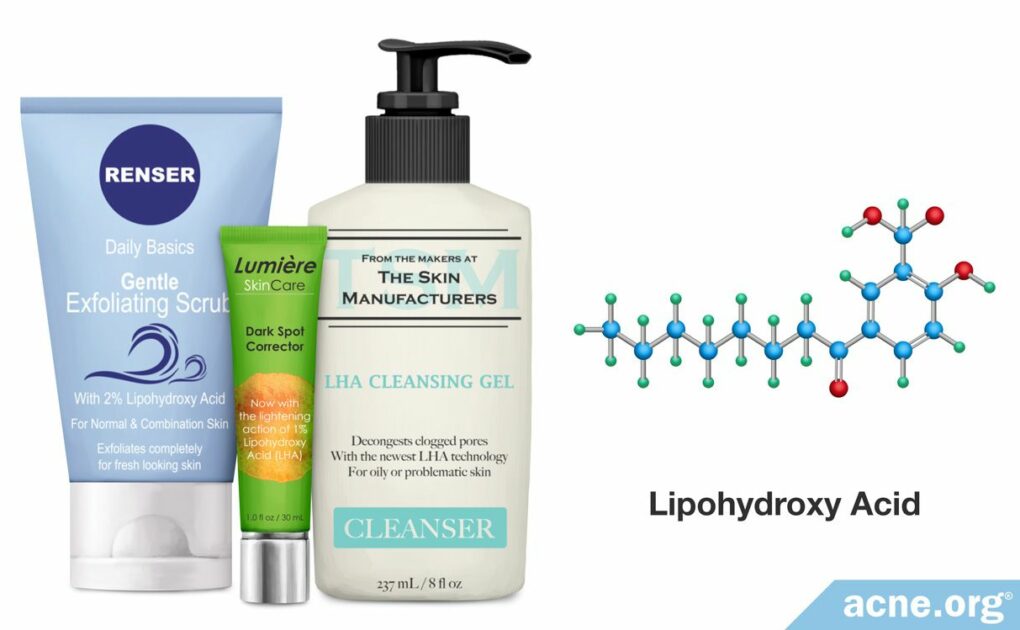Lipohydroxy Acid Works by Exfoliating the Skin, Reducing Inflammation, Decreasing Skin Oil, Reducing Bacteria, Decreasing Hyperpigmentation, and Promoting the Penetration of Acne Medications

The Essential Info
Lipohydroxy acid is a beta hydroxy acid (BHA) and can be used to treat acne.
It is created from salicylic acid, which is by far the most common BHA used to treat acne, but differs from salicylic acid in that it causes fewer side effects.
Similar to salicylic acid, lipohydroxy acid works by:
- Exfoliating the skin
- Reducing inflammation
- Decreasing skin oil
- Reducing bacteria
- Decreasing hyperpigmentation
- Promoting the penetration of acne medications
Over-the-counter Lipohydroxy Acid: Over-the-counter products contain up to 2% lipohydroxy acid, and from the research we have thus far, may produce the same or slightly better efficacy as over-the-counter salicylic acid-containing products.
Higher Percentage Lipohydroxy Acid: Professionally-administered chemical peels contain from 10-70% lipohydroxy acid.
Side Effects: Side effects of over-the-counter products are mild and include stinging, burning, and itching. Higher-percentage lipohydroxy acid chemical peels come with more severe side effects.

The Science
- Introduction to Lipohydroxy Acid
- How Lipohydroxy Acid Works to Clear Acne
- Lipohydroxy Acid Treatments for Acne
- Side Effects of Lipohydroxy Acid
- Efficacy of Lipohydroxy Acid
Introduction to Lipohydroxy Acid
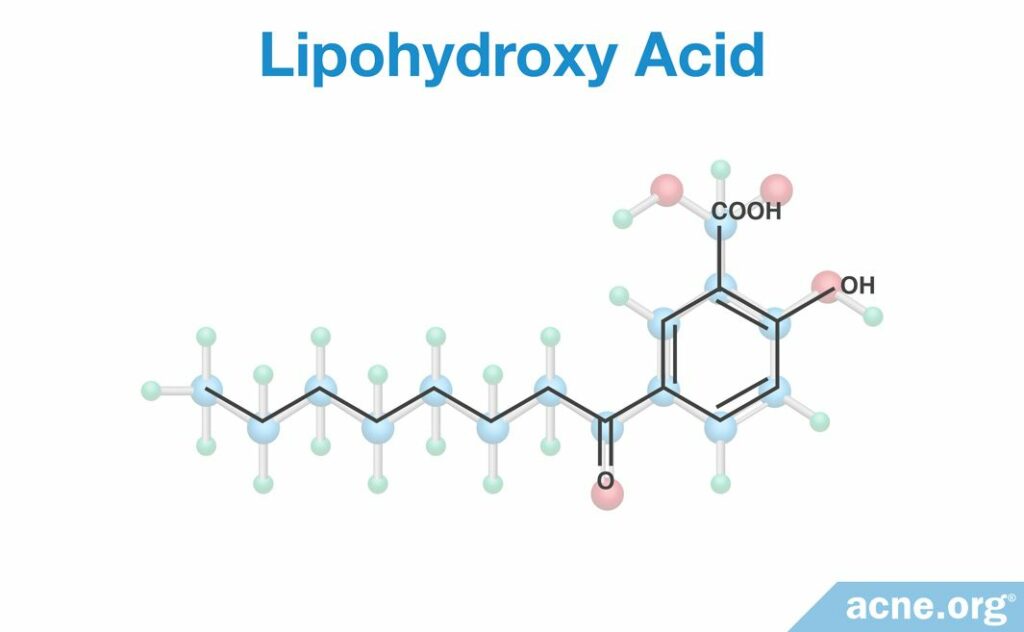
Lipohydroxy acid is a beta hydroxy acid (BHA), which is a type of acid used to treat a variety of skin diseases, including acne.
Scientists created lipohydroxy acid in the 1980s as a way to improve upon salicylic acid. To create lipohydroxy acid, the scientists added extra carbon atoms onto salicylic acid. The addition of the carbon atoms made the molecule:
- A larger molecule than salicylic acid: The larger molecular size of lipohydroxy acid prevents it from penetrating the topmost layer of skin into deeper skin layers. This helps reduce side effects. Research has found that 58% of salicylic acid penetrates into deeper areas of the skin, whereas only 6% of lipohydroxy acid penetrates that deeply.1
- More easily dissolvable in oil than salicylic acid: Lipo means “oil” or “fat.” This is where lipohydroxy acid gets its name. Clogged pores are filled with trapped skin oil. Because lipohydroxy acid is more soluble in oil, it can sneak into these clogged pores more easily where it can act to prevent acne. This property may make lipohydroxy acid more effective than salicylic acid, but research is needed to confirm this.
Overall, lipohydroxy acid works the same as salicylic acid, but comes with fewer side effects. Despite this, it is much less used.
Research investigating the effectiveness of lipohydroxy acid on acne has found that it is somewhat effective at clearing acne. However, like all hydroxy acids, it will need to be combined with acne medications for complete clearance of acne.1
How Lipohydroxy Acid Works to Clear Acne
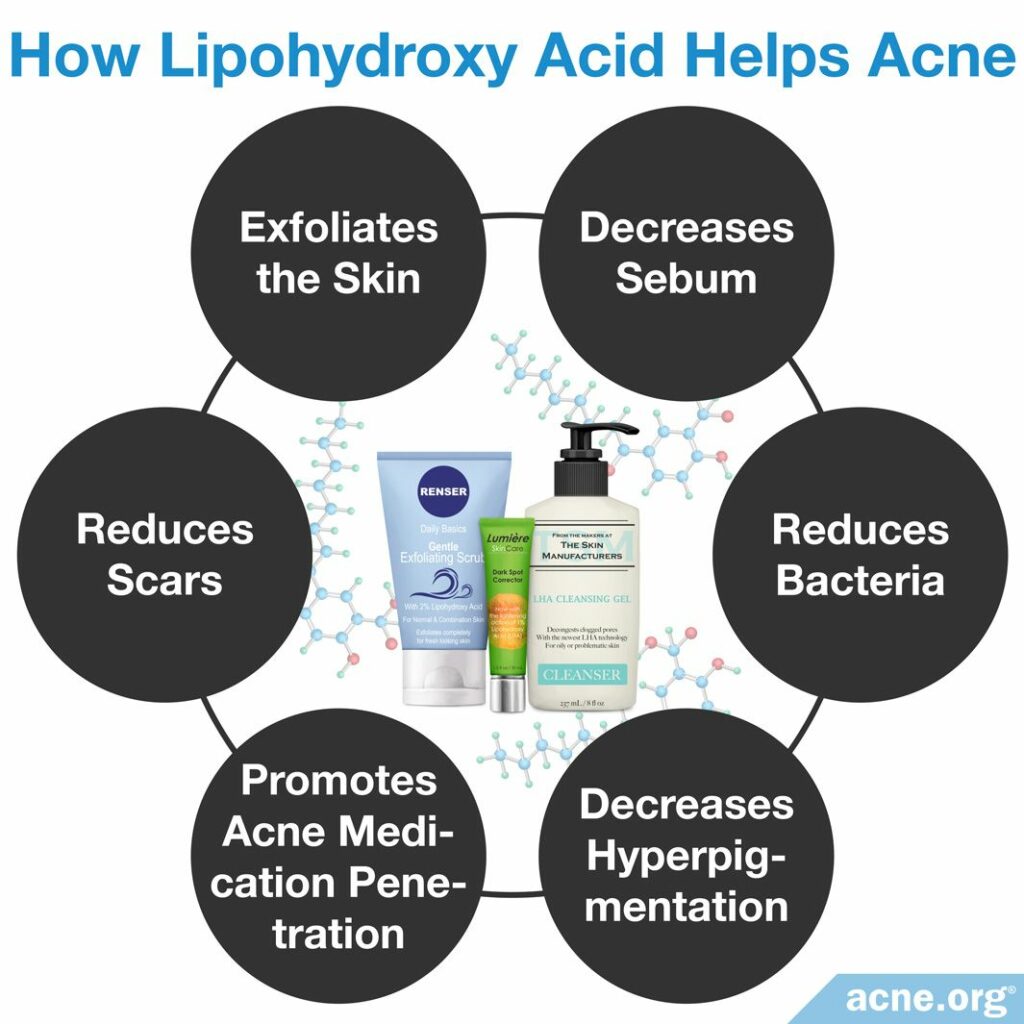
Lipohydroxy acid works to clear acne by:
- Exfoliating the skin: In acne-prone skin there is an accumulation of dead skin cells on the skin’s surface that leads to clogged pores and acne. Exfoliation of the skin can thin this layer of dead skin cells, which helps unclog pores and prevent acne. Lipohydroxy acid works to exfoliate the skin by interfering with proteins called desmosomes. Desmosomes are connector proteins that connect adjacent skin cells together, and help facilitate their accumulation on the surface of the skin. Lipohydroxy acid can break down desmosomes, which helps to exfoliate the top layer of the skin and clear clogged pores.
- Reducing inflammation: Acne is an inflammatory disease, meaning that inflammation is present in all stages of acne lesion development. Lipohydroxy acid has anti-inflammatory properties, meaning that it can combat inflammation around acne lesions.
- Decreasing skin oil: Healthy skin produces skin oil, called sebum, that helps to keep the skin healthy and protected. Acne-prone individuals often produce more sebum than non-acne-prone individuals, and this sebum can accumulate inside of a clogged pore and result in acne. Lipohydroxy acid may decrease the amount of sebum the skin produces, which helps to prevent the development of comedones (whiteheads and blackheads).
- Reducing bacteria: A bacteria called C. acnes thrives inside a clogged pore and can rapidly grow. C. acnes can make acne worse by recruiting inflammation that can make the lesion red, swollen, and sore. It also can trigger the development of pus. Lipohydroxy acid has antibacterial properties, meaning that it can decrease the amount of C. acnes inside clogged pores. This can help to prevent acne lesions from becoming inflamed.
- Decreasing hyperpigmentation: After an acne lesion heals, it may leave behind red/dark marks. Dermatologists call these marks post-inflammatory hyperpigmentation, or just hyperpigmentation for short. These marks are more common in people with non-Caucasian skin. Lipohydroxy acid can decrease hyperpigmentation by exfoliating the skin and promoting the growth of new skin cells. Hyperpigmentation decreases because new skin cells rapidly replace the old, discolored cells, and this improves the appearance of acne-hyperpigmented skin.
- Promoting the penetration of acne medications: To be effective at clearing acne, topical acne medications like benzoyl peroxide need to penetrate into the skin. A layer of accumulated dead skin cells covering the skin’s surface can prevent medications from penetrating into the skin, which reduces their effectiveness. Exfoliation of the topmost layer of skin by lipohydroxy acid makes it easier for topical acne medications to penetrate the skin, improving their effectiveness.1
Lipohydroxy Acid Treatments for Acne
Lipohydroxy acid is available in over-the-counter products and professionally administered chemical peels.
Over-the-counter products
Over-the-counter lipohydroxy acid products contain concentrations up to 2%.
However, lipohydroxy acid is not officially an “active ingredient” and therefore is not listed on the drug facts box of a product along with its percentage. Because products will not list the concentration of lipohydroxy acid, it is impossible to know how much lipohydroxy acid is in there.
However, the Food and Drug Administration (FDA) states that all BHA products must contain concentrations less than 2%, so although the concentration of lipohydroxy acid will not be listed on the product, it will not be more than 2%.
Professionally administered peels
Professionally-administered chemical peels are applied topically to the skin of the face or neck by a nurse or esthetician and allowed to sit for a period of time (usually just a few minutes) before being removed.
Lipohydroxy acid chemical peels can range in concentration from 10 – 70%. The higher concentrations make them more effective at exfoliating the skin, but also can cause more severe side effects.1,2
Side Effects of Lipohydroxy Acid
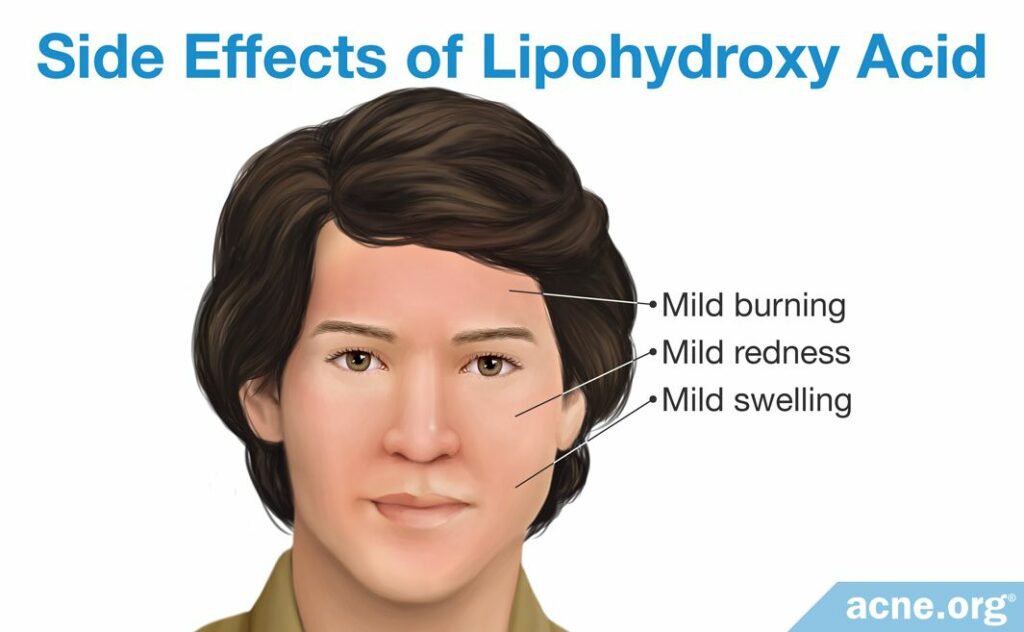
Since lipohydroxy acid was created from salicylic acid, the side effects of it are the same as those of salicylic acid. These include:
- Skin irritation
- Stinging
- Burning
- Itching
However, lipohydroxy acid is a bigger molecule than salicylic acid, and this means that it does not penetrate as deeply into the skin as salicylic acid. Lipohydroxy acid only acts on the topmost layer of dead skin cells, and does not penetrate into the deeper areas of the skin with live skin cells. In other words, it exfoliates just enough cells to help clear acne, without exfoliating too many skin cells and damaging the skin.
Since lipohydroxy acid cannot penetrate as deeply into the skin as salicylic acid, the severity of the side effects of lipohydroxy acid are generally milder than that of salicylic acid.1
Sun sensitivity
Lipohydroxy acid is a BHA, and BHAs most likely do not cause the skin to become sensitive to the sun. Lipohydroxy acid in particular has antioxidant properties that may actually increase the skin’s tolerance to the sun’s rays. In other words, lipohydroxy acid may make the skin less likely to burn.
Efficacy of Lipohydroxy Acid
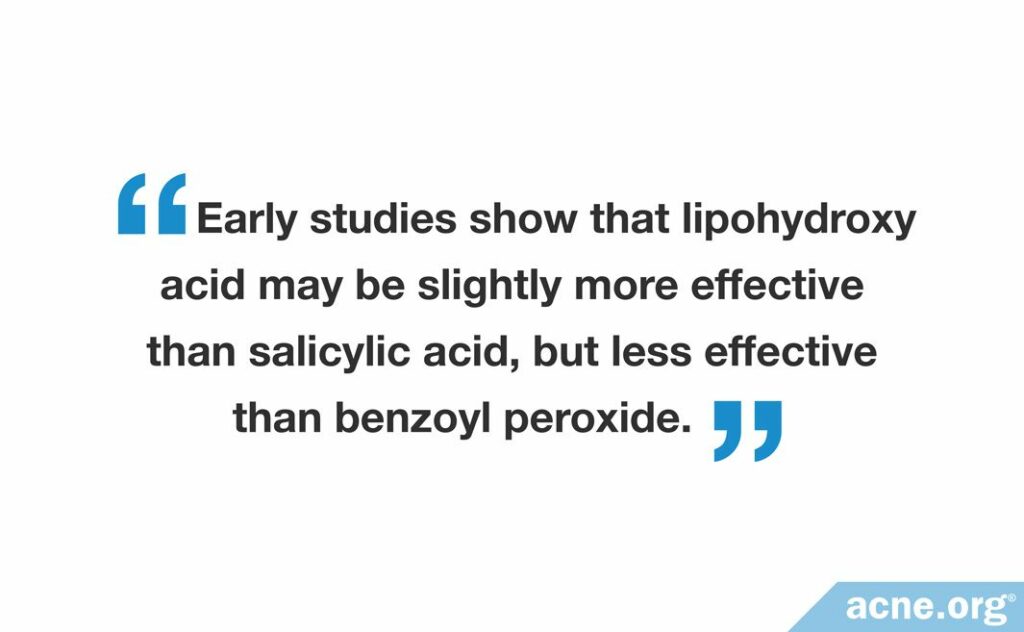
There are three studies investigating the effect lipohydroxy acid has on acne.
These early studies show that lipohydroxy acid may be slightly more effective than salicylic acid, but less effective than benzoyl peroxide.
However, these results depend on the particular concentration of lipohydroxy acid studied, and more research is needed before the effect of lipohydroxy acid on acne is known.
Expand to read details of these three studies
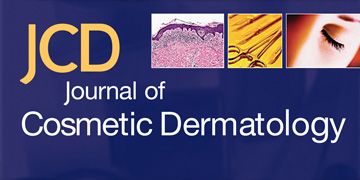
A 2009 study published in the Journal of Cosmetic Dermatology compared the ability of 3% lipohydroxy acid to that of 5% benzoyl peroxide to clear acne. This study was performed with 80 participants applying either the lipohydroxy acid or benzoyl peroxide treatment twice daily for 12 weeks. The researchers found that benzoyl peroxide was slightly more effective than lipohydroxy acid, as it was able to clear 47% of inflammatory acne lesions, such as papules, pustules, nodules, and cysts, while lipohydroxy acid cleared 44% of inflammatory lesions. As for non-inflammatory lesions like whiteheads and blackheads, benzoyl peroxide cleared 23% and lipohydroxy acid cleared 19% of lesions.2

A 2011 study published in the Journal of Cosmetic Dermatology compared the effects of a 10% lipohydroxy acid peel to those of a 30% salicylic acid peel on acne. This study was performed with both the lipohydroxy acid peel and the salicylic acid peel being applied to each half of 20 participants’ face a total of six times for 12 weeks. The researchers found that the lipohydroxy acid peel decreased the number of non-inflammatory acne lesions by 55.6%, while the salicylic acid peel cleared the number of non-inflammatory acne lesions by 48.5%.3
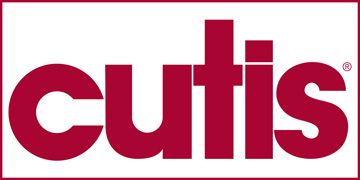
A 2012 study published in the journal Cutis tested the efficacy of a combination treatment that included lipohydroxy acid. The researchers gave 33 patients with mild-to-moderate acne a treatment consisting of 5.5% benzoyl peroxide with lipohydroxy acid every morning. In addition, the patients also applied a 0.025% tretinoin cream to their skin every evening.
This treatment regimen continued for 12 weeks. After that period, the researchers found that the treatment had significantly improved the patients’ acne. The researchers concluded that while benzoyl peroxide appeared to be responsible for most of the anti-acne effect, lipohydroxy acid may have helped clear the skin of the patients.4
References
- Saint-Léger, D., Lévêque, J. L. & Verschoore, M. The use of hydroxy acids on the skin: Characteristics of C8 -lipohydroxy acid. J Cosmet Dermatol 6, 59 – 65 (2007). https://www.ncbi.nlm.nih.gov/pmc/articles/PMC5504780/
- Bissonnette, R. et al. Randomized study comparing the efficacy and tolerance of a lipophillic hydroxy acid derivative of salicylic acid and 5% benzoyl peroxide in the treatment of facial acne vulgaris. J Cosmet Dermatol 8, 19 – 23 (2009). https://www.ncbi.nlm.nih.gov/pubmed/19250161
- Levesque, A., Hamzavi, I., Seite, S., Rougier, A. & Bissonnette, R. Randomized trial comparing a chemical peel containing a lipophilic hydroxy acid derivative of salicylic acid with a salicylic acid peel in subjects with comedonal acne. J Cosmet Dermatol 10, 174 – 178 (2011). https://www.ncbi.nlm.nih.gov/pubmed/21896127
- Zeichner, J. A. The use of lipohydroxy acid in skin care and acne treatment. J Clin Aesthet Dermatol 9, 40-43 (2016). https://www.ncbi.nlm.nih.gov/pubmed/28210389
 Acne.org Products
Acne.org Products